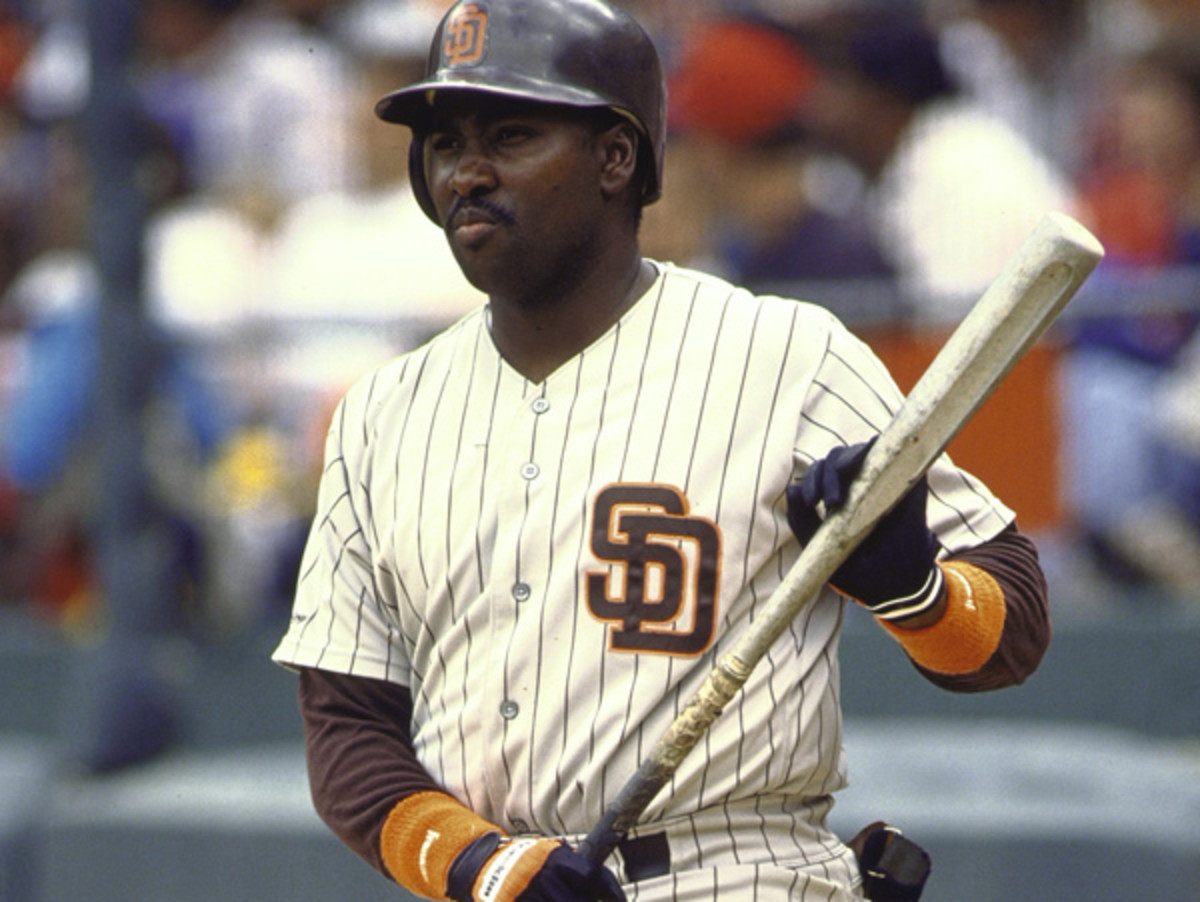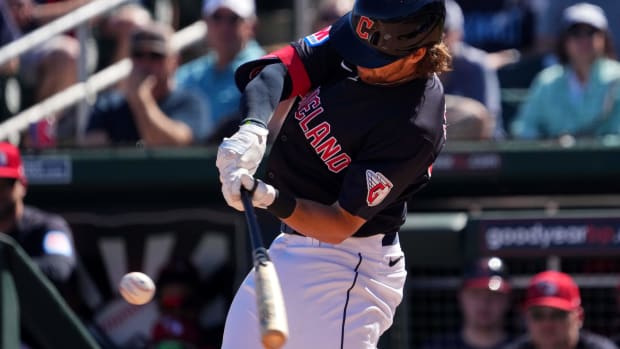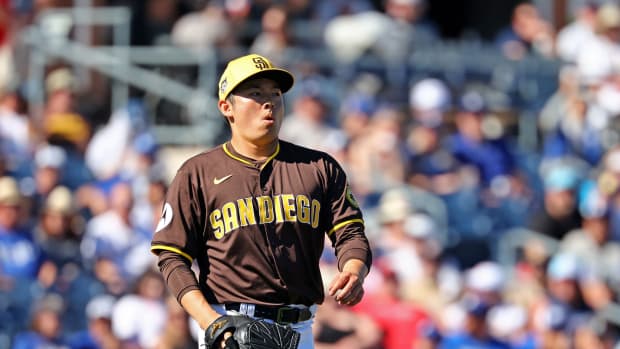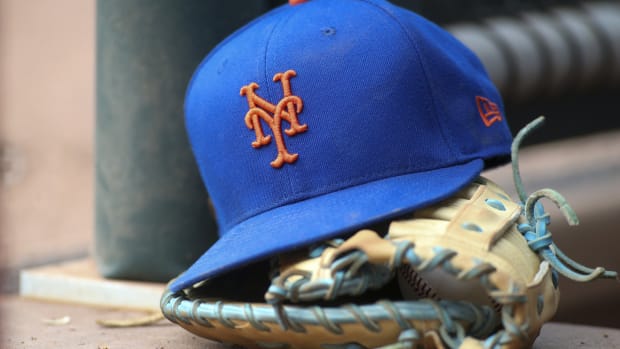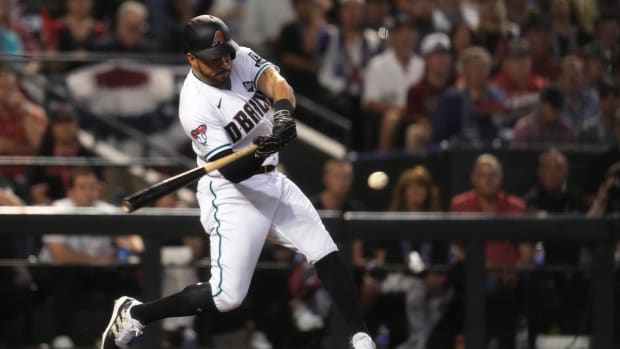Tony Gwynn, a pioneer, a legend and a Hall of Famer, dies at age 54
Tony Gwynn was a 15-time All-Star and won eight batting titles in his 20-season MLB career. (V.J. Lovero/SI)
You have reached your limit of 4 premium articles
Register your email to get 1 more
Hall of Famer Tony Gwynn, who won eight batting titles and racked up 3,141 hits while earning All-Star honors 15 times in a 20-year major league career with the Padres, passed away early Monday morning. Just 54 years old, Gwynn had been on leave from his job as the head baseball coach at San Diego State University to battle a recurrence of salivary gland cancer.
Viewed from a distance during an age where the home run and the strikeout have become the game's signature events, Gwynn stands as an anachronism. With a sweet lefthanded swing and a knack for hitting to the opposite field -- he made "the 5.5 hole," the gap between the shortstop and third baseman, famous -- Gwynn racked up single after single. In fact, his 2,378 singles rank as the 10th-most in history and the fourth-highest since World War II behind only Pete Rose, Derek Jeter and Rod Carew. Gwynn never homered more than 17 times in a season and reached double digits in just two of the eight seasons in which he won a batting title. Meanwhile, he had six seasons where he qualified for a batting title while striking out fewer than 20 times, more than any player in the post-1960 expansion era.
CORCORAN: Ranking Tony Gwynn's 10 best seasons
Gwynn topped a .300 batting average in every season except his 1982 rookie campaign, when he hit .289 in 209 plate appearances. He hit over .350 seven times, more than any player since World War II; that count includes the 1996 season when he officially fell four plate appearances short of qualifying but was far enough ahead of the pack to be awarded the batting title. His eight batting titles tied Honus Wagner for the NL record; only Ty Cobb had more. A 1997 Sports Illustrated cover hailed Gwynn as "The Best Hitter Since Ted Williams." Indeed, his .394 batting average in the strike-shortened 1994 season stands as the highest since Williams hit .406 in 1941, and his career .338 mark is the highest of any player since Williams hit .344 in a career that ended in 1960.
Gwynn was also a pioneer in using video to study pitchers. In September 1989, Peter Gammons noted in SI that the superstar and his wife had been videotaping his at-bats for seven seasons, to the point that he traveled with a videocassette recorder. "I'm the real Captain Video," he told Gammons. "After a couple of years, I knew what I was doing, then I started seeing what pitchers were trying to do to me and how they tip pitches."
In this 1989 episode of This Week in Baseball, Gwynn explained his use of video, first to correct his bad habits, then to scout opposing pitchers:
[mlbvideo id="33770083" width="600" height="424" /]
Gwynn invested more than $100,000 of his own money for video equipment that he shared with his Padres teammates. Personal computers and portable devices have since made the practice of players using video to review their at-bats and scout opposing pitchers commonplace.
Gwynn was born in Los Angeles on May 9, 1960 and raised in Long Beach, but it was in San Diego where he became an icon. He attended San Diego State on a basketball scholarship, a pudgy point guard who could play despite his less-than-imposing 5-10 height. He earned All-Western Athletic Conference honors twice for his hoops skill and didn't even play baseball until his sophomore year, though he quickly showed himself to be a star there, too. He was a two-time All-America on the diamond, and he remains the only player ever to earn All-WAC honors in two sports.
HAMILTON: Remembering Tony Gwynn's impressive college basketball career
Gwynn was chosen by the Padres in the third round of the 1981 draft; later that day, he was picked by the NBA's Clippers in the 10th round. He chose baseball due his difficulty of matching up with larger guards and reported to Class A Walla Walla of the Northwest League; there he played in an outfield that also featured future major leaguer John Kruk as well as Mark Gillaspie, father of current White Sox third baseman Conor Gillaspie and 2014 Rays first-round pick Casey Gillaspie. I saw that outfield several times as an 11-year-old, as my grandparents lived in Walla Walla, and I was particularly attuned to Gwynn, having seen him play basketball against my hometown University of Utah.
Though he initially struggled to adapt to wooden bats — eventually choosing a 32-ouncer to replicate more closely the light feel of the aluminum bats he had used in college — Gwynn wasn't long for the Northwest League, hitting .331/.406/.612 with 12 homers in 42 games. That performance was good enough to earn league MVP honors as well as a promotion to Double A Amarillo, where he hit a sizzling .462/.490/.725 in 23 games. By the middle of the next season he was in the majors. Debuting on July 19, 1982, 13 1/2 months after being drafted, he went 2-for-4, collecting a double off the Phillies' Sid Monge for his first hit. He hit a thin .289/.337/.389 in 54 games as a rookie, missing two and a half weeks after breaking his left wrist while diving for a flyball. He then broke his right wrist while playing winter ball in Puerto Rico, and missed the first 65 games of the 1983 season before returning to hit .309/.355/.372.
Instead of breaking a bone in 1984, Gwynn broke out. He hit .351/.410/.444 in that, his first full season, racking up 213 hits, 33 steals and 10 triples while drawing 59 walks and striking out just 23 times. He earned his first All-Star selection, won his first batting title (by 30 points) and finished third in the NL MVP balloting, the only time he would rank in the top-five. Alongside veterans Steve Garvey, Graig Nettles and Goose Gossage, Gwynn's performance helped lift the Padres to 92 wins and their first NL West flag and pennant in franchise history. He then hit .368 in the NLCS against the Cubs, with his two-run double off Rick Sutcliffe breaking a 3-3 tie in the seventh inning of the decisive Game 5, but he cooled off against the Tigers in the World Series, going 5-for-19 in a five-game defeat. It would be 12 years before he returned to the playoffs and 14 before he and San Diego made it to another World Series.
Gwynn spent the rest of the decade solidifying his status as the Senior Circuit's top hit machine (Wade Boggs staked that claim in the Junior Circuit via five batting titles from 1983-88). He topped 200 hits in 1986, '87 and '89, leading the league in all three seasons, and he won three straight batting titles in 1987 (.370/.447/.511, accompanied by a career-high 56 steals), '88 (.313/.373/.415) and '89 (.336/.389/.424). His defense gained acclaim as well; he earned Gold Gloves in each of those 200-hit seasons, and he led the league in Wins Above Replacement in both 1986 (6.6) and '87 (8.5).
Tony Gwynn made two World Series appearances with the Padres, in 1984 and again in 1998. (Walter Iooss Jr./SI)
Despite his continued brilliance, Gwynn's career had some sour moments in the early 1990s as he crossed into his 30s. He hit a combined .314/.361/.421 from 1990-92, topping out at a .317 batting average in the latter two of those three years and placing no higher than third in the NL batting race, but he also drew criticism from teammates for his increasing weight and for the perception that he cared more about his batting average and his contract than the welfare of his team. He feuded with slugger Jack Clark, who was believed to be behind the hanging of a mutilated Gwynn doll in the Padres clubhouse. While not naming him directly, teammate and ex-Yankee Mike Pagliarulo was clearly talking about Gwynn when he told the New York Daily News, "He cares only about his hits. If we win, and he goes zero for four, forget it, he's ticked. If he gets his hits, and we lose, that's fine with him. He doesn't give a ---- about this team, and that's weak. Donnie (Mattingly) would've kicked that guy's ass the first day." The charges were odd, considering the frequency with which Gwynn bunted to move runners over because, as he claimed, he didn't pull the ball well.
A mid-September broken finger prematurely ended Gwynn's bitter 1990 season, San Diego's only losing campaign in a five-year stretch. That was a harbinger of things to come, as injuries kept him from topping 135 games in all but one of his final 11 seasons. Nonetheless, he recovered his stroke. He hit .358/.398/.497 in 1993, his best in all three categories since 1987, and while he was only the runner-up in that year's batting race (the Rockies' Andres Galarraga won with a Mile High Stadium-aided .370), he reeled off batting titles in each of the next four seasons while hitting a combined .371/.415/.511.
Gwynn spent the 1994 season looking as through he would give .400 a legitimate run. Though he was last above .400 on May 15, he hit .414 over his final 47 games from June 21 through Aug. 11, when the players' strike hit. He finished the year at .394/.454/.568; not only was that the highest batting average since Williams, it was the highest in the NL since Bill Terry hit .401 in 1930. He cranked out 197 hits — his most since 1989 — in the strike-shortened 1995 season and climbed back above 200 in '97, with a career-best 220; his 17 homers, 49 doubles and 119 RBIs set career highs as well. A right Achilles injury cost him five weeks on the disabled list in 1996; his 498 plate appearances fell four short of officially qualifying for the batting crown, but even with the addition of four phantom at-bats, he beat out the Rockies' Ellis Burks — to date the only time Major League Baseball ever invoked Rule 10.22(a) in crowning a batting champion.
Underlying Gwynn's late-career resurgence was a 1996 conversation with Williams that helped him better handle inside pitches and pull the ball more often. From the 1997 SI cover story by Tom Verducci:
The change began with a conversation he had with Williams before last season. "We talked for two hours," Gwynn says, "and we must have spent 50 minutes talking about the inside pitch." Gwynn already had won six of his seven National League batting titles, including the crown for the strike-shortened 1994 season that he got with a .394 average, and amassed Hall of Fame credentials by allowing the inside pitch to get to the plate before, as he likes to say, "carving" the ball through the hole between third base and shortstop. Williams insisted that a good hitter meets the inside pitch in front of the plate. He picked up his cane, snapped at an imaginary inside fastball and shouted at Gwynn, "You've got to turn on it! You've got to let it go! Let it go!"
Gwynn helped the Padres to 91 wins and the NL West title in 1996, but they were swept by the Cardinals in the Division Series. Though his Achilles limited him to just 127 games in 1998, his .321/.364/.501 showing with 16 homers helped San Diego to a franchise-record 98 wins and its second pennant. He went 8-for-16 with a home run in the World Series, but his teammates hit just .203, and the Padres were swept by a juggernaut Yankees team that won 125 games that year, postseason included.
A recurrent calf injury cost Gwynn 44 games in the first half of the 1999 season, prolonging his climb toward 3,000 hits. At the All-Star Game at Fenway Park, he escorted Williams onto the field and to the mound for the ceremonial first pitch. On Aug. 6, 1999, he became the 22nd player to reach that plateau, doing so with a single off the Expos' Dan Smith at Montreal's Olympic Stadium as part of a four-hit game.
[mlbvideo id="20567989" width="600" height="424" /]
Knee troubles requiring season-ending surgery limited Gwynn to just 36 games in 2000, his age-40 season. He returned for one more campaign, but because of a bad hamstring he played just 17 games in the field and made 112 plate appearances, mainly as a pinch-hitter; even then he hit a robust .324/.384/.461. He collected his final hit on Oct. 6, 2001, a pinch-double off the Rockies' Gabe White.
Gwynn retired at the end of the season, just the 10th player to do so with more than 3,000 hits and 300 stolen bases (today there are 13). In chronological order:
Player | H | SB | AVG/OBP/SLG |
Nap Lajoie | 3243 | 380 | .338/.380/.466 |
Honus Wagner | 3420 | 723 | .328/.391/.467 |
Tris Speaker | 3514 | 436 | .345/.428/.500 |
Ty Cobb | 4189 | 897 | .366/.433/.512 |
Eddie Collins | 3315 | 741 | .333/.424/.429 |
Willie Mays | 3283 | 338 | .302/.384/.557 |
Lou Brock | 3023 | 938 | .293/.343/.410 |
Rod Carew | 3053 | 353 | .328/.393/.429 |
Paul Molitor | 3319 | 504 | .306/.369/.448 |
Tony Gwynn | 3141 | 319 | .338/.388/.459 |
Rickey Henderson | 3055 | 1406 | .279/.401/.419 |
Craig Biggio | 3060 | 414 | .281/.363/.433 |
Derek Jeter | 3380 | 351 | .312/.380/.444 |
Gwynn took over as coach at his alma mater in 2002 in time to join son Tony Gwynn Jr., who was a second-round pick by the Brewers in 2003 and has since spent parts of eight seasons in the majors (he's now a reserve on the Phillies). Among the future major leaguers he oversaw were Justin Masterson and 2009 overall number one pick Stephen Strasburg. In 2007, Gwynn was elected to the National Baseball Hall of Fame with 97.6 percent of the vote, a share surpassed by only six players: Hank Aaron, George Brett, Ty Cobb, fellow 2007 inductee Cal Ripken, Nolan Ryan and Tom Seaver (who holds the record at 98.84 percent).
Alas, Gwynn's time since election was dominated by major health woes. After his weight ballooned to 330 pounds, he underwent gastric banding surgery in 2009, needed an operation to remove a damaged disc in his back in 2010 and was diagnosed with cancer in a salivary gland later that year; he had previously undergone surgeries to remove noncancerous growths on his parotid gland, which he believed was linked to his habit of chewing tobacco. He underwent another surgery to remove a malignant tumor in his right cheek in 2012 and went on medical leave back in March for further treatment. Despite his health woes, he had just received a contract extension last week.
Gwynn might have gained bigger stardom had he sought free agent riches instead of sticking with the Padres for the entirety of his career. As it was, he never earned more than $6.3 million in a season, or signed a contract worth more than $12.25 million, but he's indelibly identified with the city of San Diego for his college, professional and post-career days, and a statue of him stands outside Petco Park. As an ambassador for the game, his enthusiasm, radiant smile and sweet stroke will be remembered far beyond that city's borders.
[si_video id="video_B607E322-BB97-F504-E8C3-A616C1147F02" height="470"]






























